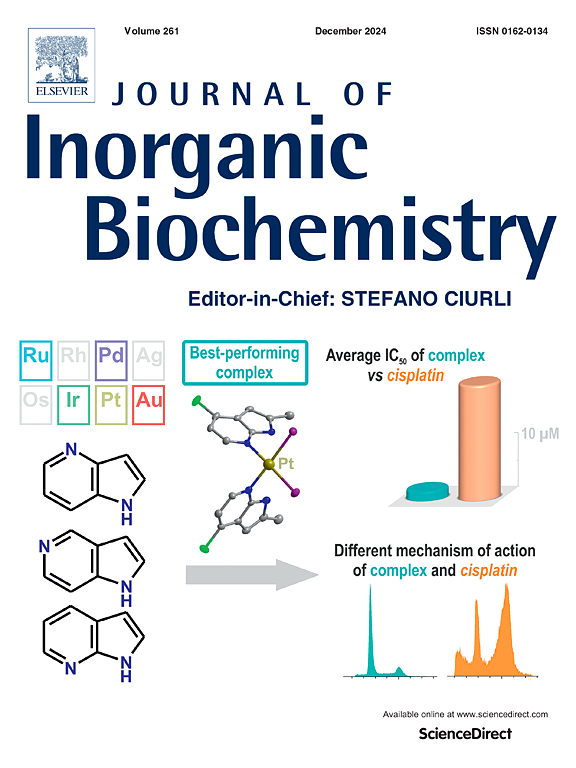4-苯基丁酸偶联铂二亚胺配合物:体外光细胞毒性、细胞周期阻滞和凋亡
IF 3.8
2区 化学
Q2 BIOCHEMISTRY & MOLECULAR BIOLOGY
引用次数: 0
摘要
4-苯基丁酸(PBA)是一种 I 类和 II 类组蛋白去乙酰化酶抑制剂,可减少细胞增殖、促进细胞分化、诱导多种癌细胞凋亡和细胞周期停滞。为了增强光动力疗法的疗效,我们制备了 PBA 改性光活性铂二亚胺复合物,并对其进行了表征。此外,还研究了其产生单线态氧的能力、在酯酶存在下的行为、光毒性、细胞周期分布以及在 MCF-7 细胞中的凋亡诱导能力。结果表明,PBA 修饰的二亚胺铂复合物能产生良好的单线态氧,在酯酶存在下释放 PBA,诱导肿瘤细胞产生强烈的光毒性(IC50 值为 3.67 ± 0.67 μM),使细胞周期停滞在 S 期,并通过细胞凋亡诱导细胞死亡,凋亡细胞总数的百分比为 34.65%。结果还显示,PBA 可能能够调节光敏剂诱导的肿瘤细胞周期停滞模式。本文章由计算机程序翻译,如有差异,请以英文原文为准。

A 4-phenylbutyric acid-conjugated platinum diimine complex: Photocytotoxicity, cell cycle arrest and apoptosis in vitro
4-phenylbutyric acid (PBA) is a class I and II histone deacetylase inhibitor, which can decrease cell proliferation, enhance cell differentiation, and induce apoptosis and cell cycle arrest in various cancer cells. PBA-modified photoactive platinum diimine complex has been prepared and characterized to augment its photodynamic therapy efficacy. Its ability to generate singlet oxygen, behavior in the presence of esterase, photocytotoxicity, cell cycle distribution, and apoptosis-inducing ability in MCF-7 cells have also been studied. The results suggested that the PBA-modified platinum diimine complex could act as a good singlet oxygen producer, release PBA in the presence of esterase, induce potent photocytotoxicity in tumor cells with a IC50 value of 3.67 ± 0.67 μM, arrest cell cycle at S phase, and induce cell death via apoptosis with the percentage of total apoptotic cells being 34.65 %. The results also revealed that PBA might be able to modulate the mode of cell cycle arrest induced by the photosensitizer in tumor cells.
求助全文
通过发布文献求助,成功后即可免费获取论文全文。
去求助
来源期刊

Journal of Inorganic Biochemistry
生物-生化与分子生物学
CiteScore
7.00
自引率
10.30%
发文量
336
审稿时长
41 days
期刊介绍:
The Journal of Inorganic Biochemistry is an established international forum for research in all aspects of Biological Inorganic Chemistry. Original papers of a high scientific level are published in the form of Articles (full length papers), Short Communications, Focused Reviews and Bioinorganic Methods. Topics include: the chemistry, structure and function of metalloenzymes; the interaction of inorganic ions and molecules with proteins and nucleic acids; the synthesis and properties of coordination complexes of biological interest including both structural and functional model systems; the function of metal- containing systems in the regulation of gene expression; the role of metals in medicine; the application of spectroscopic methods to determine the structure of metallobiomolecules; the preparation and characterization of metal-based biomaterials; and related systems. The emphasis of the Journal is on the structure and mechanism of action of metallobiomolecules.
 求助内容:
求助内容: 应助结果提醒方式:
应助结果提醒方式:


